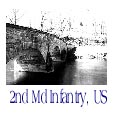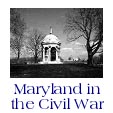

The history of the 1st Maryland Cavalry begins with the decision of 18 members of Co. K., 1st Va Cavalry not to re-enlist on May 15, 1862, after serving a year in the Confederate Army. Co. K. was predominatly Marylanders and had served with Stuart's 1st Va almost from the outset of the war. These men believed that Maryland should have it's own Cavalry Regiment and so they set out to raise it. Recruiting was brisk, and Co. A. was quickly formed with CPT Ridgely Brown at it's helm. Co. A. would provide the nucleus around which the regiment would be built, but it would have to be built in the field. Co. A. was ordered to the Valley and attached to Colonel Munford's 2nd Va until a full battalion of cavalry could be raised.
The 1st Md's initial history is one and the same as the 2nd Va's. It participated in Jackson's Valley Campaign, distinguishing itself at Harrisonburg against the 1st N.J. Cavalry. It supported the 1st Maryland Infantry at Cross Keys. Was with Jackson at Richmond, Manassas and Antietam. Gradually the small command took shape. Co. A. was soon joined by B., C. & D. On Nov 25th at Winchester the battalion was officially formed. CPT Brown was promoted to Major and placed in command of the battalion. Shortly afterwards two additional companies were formed.
The 1st Md. spent the winter of 62/63 at various points in the Valley performing mostly picket duty. On Jan 2nd they accompanied General Grumble Jones on an expedition to Moorefield that amounted to little more than a patrol en masse. On February 25th while on picket duty near Strasburg, Cpt's Bond and Dorsey, commanding Co's A. & D. took it in their heads to probe the Federal position near Winchester. Two miles out of town on the Cedar Creek road they ran through a Federal picket. They did it again at the Staunton Road junction. They shot up a third picket in a nearby house. At Kernstown they attacked a mounted picket, capturing 15 horses and 14 men, while only loosing one man. As Bond smugly returned to Strasburg with his booty, General Milroy dispatched the 1st N.Y. and 13th Pa Cavalry to intercept him. Co's B. & G. were sent out on the morning of the 26th to relieve Co's A & D. Instead they ran smack into the Federal cavalry. Fortunately General Jones, at the head of Colonel Funston's 11th Va was near by. A full out cavalry battle soon ensued. Eventually the Federal cavalry was successfully driven off. Bond and Dorsey's little adventure though resulted in the capture of over 200 Federal troops and horses.
On Apr 21st Jones left Lacey Springs on a raid into W.Va. At Greenland Pass, the command was held up by a garrison which had occuppied a church that had complete command of the pass. The cavalry was unable to carry the church. Fighting dismounted, elements of the 1st Md attacked the church after dark and set it on fire. Jones divided his command and the 1st Md. rode with the 12th Va. and McNeil's Partisan Rangers to Oakland, where 40 prisoners were taken and the railroad bridge was damaged. That night Morgantown was captured. Soon after the command reunited and began retracing it's steps back to Virginia. On the 29th, with Co. E. fighting dismounted to hold the attention of Federal infantry, the remainder of the battalion encircled approx 300 Federal troops. On the 30th the battalion captured a company of Federal cavalry at Bridgeport. Jones then moved to Oiltown and destroyed a large quanity of oil and machinery. Then Jones moved back to his base in the Valley.
Back in the Valley, the 1st Md. was directed to join the 2nd Maryland Inf. and Baltimore Light Artillery at Fisher's Hill. General Jenkins arrived there several days later and assumed command of the lot. On Jun 10th he moved his command to Cedar Creek. On the 12th, Co. E., riding with Harry Gilmor and eight of his men, and a party from the 14th Va Cavalry, ran into a superior force of combined arms, artillery, infantry and cavalry. In the skirmish that followed Co. E. suffered 5 dead, and the wounding and capture of 30 others. On Jun 12th Jenkins moved toward Front Royal. He left behind his Md. infantry and artillery, and Co. A., 1st Md. Cavalry, who were directed to join General Ewell at Winchester. Through out the remainder of the Gettysburg Campaign, Co. A. served as Ewell's recon arm and as couriers. The remainder of the battalion was temporarily placed under the command of Major Harry Gilmor, who was instructed to strike out ahead of Ewell's Corps and attempt to secure the bridge over the Monocacy River near Frederick. Finding the bridge to strongly guarded, Gilmor moved to South Mountain, then to Hagerstown. Here he was directed to support George Hume Steuart's Brigade on its expedition to Chambersburg and Carlisle via McConnellsburg, to collect horses, cattle and shoes.
Just short of Carlisle, Gilmor was directed to report to General Ewell somewhere south near a town called Gettysburg. Upon his arrival on the 1st, Gilmor was directed to provide support to Pogue's and Carter's batteries. Co. A., was placed on provost duty in the town, and saw no action. As the battle progressed the 1st Md. was used exclusively as couriers and to support artillery. They saw no mounted action, despite what some historians write about their taking part in the great cavalry battle east of Gettysburg on the third day.
Though their role at Gettysburg was less than glamour, Lee's trek back to Virginia would provide some of the 1st Md. most stelar moments. The battalion was scattered out along Ewell's trains to provide protection from marauding Federal cavalry. Cpt Emack, Co. B. was directed to picket the Emmitsburg Road near Monterey. Emack's stand there against the full might of General Kilpatrick's Cavalry has become legendary, and has been presented in such fine magazines as Civil War Times. With 50 men and a single gun, Emack held off numerous attacks by Kilpatrick. He was eventually joined by Co. G. This small band of spartans valiantly held their Thermoplye until the bitter end, when a charge by Kilpatrick, shortly after 3:00 A.M. swept the Marylanders aside. On the 6th, the 1st Md. played a prominent role in the cavalry battle that rolled back and forth through the streets of Hagerstown.
After it's return to Virginia, the 1st Md. was assigned to the Brigade of General Lomax. It remained near Leetown until Oct 11th performing picket duty and the occassional skirmish. On the 11th the 1st moved with Fitzhugh Lee's division toward the Rappahannock, where it participated in the engagement at Morton's Ford and later in the day at Brandy Station. They participated in several skirmishes while Lee and Meade attempted to manuver around one another. When the two armies settled into winter quarters, the 1st Md was directed to move to Hanover Junction, where Colonel Bradley Johnson was forming the "Maryland Line." Here they joined the Maryland Artillery units, 1st, 2nd and 4th, as well as the 2nd Md Infantry.
In the spring of 1864 Judson Kilpatrick attempted a cavalry raid on Richmond. On Mar 1st Colonel Johnson received a telegram from Lee's HQ, informing him that a large body of cavalry was passing his right flank. Most of the 1st Md. was out on patrol. Scouts from the 1st Md. found two columns, one of a bout 500 riders moving fast toward the James about 20 miles above Richmond; and one of aprrox 3500 sabers. Having only 60 men at his disposal,Johnson was unable to directly atttack Kilpatrick. Instead he kept snapping at his rear and flanks, capturing a number of men. After capturing a courier from Colonel Ulric Dahlgren, commanding the smaller column, which announced his plan to attack Richmond, Johnson deliberately charged into Kilpatrick's rear guard, creating such a havoc that Kilpatrick believed he was being attacked by a superior force. Distracted, Kilpatrick was unable to asit Ulric, whose attack became a disaster. Johnson then dogged Kilpatrick for the next day. When Kilpatrick would draw up his forces to do battle Johnson would melt away. He took care never to reveal his true strength, and kept Kilpatrick at bay until Hampton's cavalry came up the following day. It was during this action that the infamous orders of Dalgren's to kill President Davis were found.
Again in May, when Sheridan struck for Richmond, the plucky 1st Md found itself dogging Sheridan's column. Shortly after 11:00 P.M. on the night of the 9th Colonel Ridgely Brown with 150 sabers came upon the came of what they had supposed was a small raiding party. Brown dismounted, formed a skirmish line and attacked the camp. He soon became embroiled in a hot fire fight. From his prisoners he learned that he had taken on a portion of Sheridan's column. He held his ground against counter-attacks until daylight. Then he received a dispatch from JEB Stuart who was massing his cavalry in an order to intercept Sheridan. Stuart asked Brown to delay Sheridan as long as he could. Through out the morning Brown repeatedly pushed in Sheridan's pickets. The Federals responded by mounting a charge, which the Marylanders repulsed. For some time the two forces eyed one another, neither able to determine the other's size due to the dense woods. Sheridan's men attempted to charge the Marylanders, but they, slipped away and returned to Hanover Junction.
In the later part of May Johnson led the 1st Md on a scout of Grant's flank and reported back to General Lee that they had encountered columns of infantry moving down from Bowling Green. Johnson was then directed to join Fitz Lee at Hanover Court House. Enroute, the 1st Md. encountered the 5th N.C. Infantry engaged with Federal troops near Dabney's Ferry. In the hand to hand fighting that quickly ensued, the 1st Md found itself pinned in a fenced area and unable to manuver. Johnson's horse was shot out from under him, and the beloved Colonel Brown was wounded. The regiment lost nearly 50 men in this, the battle of Pollard's Farm. Due to the Marylanders' sacrifice the North Carolinians were able to extract themselves from their melee with Custard's Brigade.
The battalion was hotly engaged in minor skirmishes over the next couple of days. On Jun 1st it fought a six hour struggle to defend the South Anna Bridge, during which Colonel Brown was killed. Again Sheridan moved toward Richmond. Wade Hampton moved to intercept. The 1st Md joined Hampton at Trevallion Station and fought on the right of his line. Custer broke through Hampton's line at one point, but General Rosser drove him back to his own wagons, and the 1st Maryland was with Rosser and avenged themselves for their losses at Pollard's Farm.
During the winter of 63/64 Johnson had formed a plan to kidnap President Lincoln. After Trevallion Station Hampton gave him leave to attempt it. Johnson moved his battalion into the Valley to collect fresh horses and rest his men and animals before they set off for Maryland. It was at this time that Jubal Early began his move toward Maryland. Early added the 1st Md it to his command. Johnson was promoted to General and both Gilmor's Partisans and the remnants of Grumble Jones' Brigade were added to Johnson's cavalry giving him a full brigade.
As Early advanced on Harper's Ferry he divided his command to secure Martinsburg and Leetown.Johnson led Early's advance to Leetown and on Jul 3rd encounter a strong Federal cavalry force near Leetown. A severe engagement followed. Johnson was driven back on his reserves, then pressed forward driving the Federals through the town. Johnson crossed the Potomac on the 5th. At this time General McCausland moved to take Hagerstown and Johnson pressed across South Mountain toward Frederick. On the 8th he encountered Clendenin's Illinois Cavalry and pushed it back towards Frederick. In front of Frederick he brought up the Baltimore Light, which engaged the _______in a cannon duel.
On the evening of the 8th Johnson was called to Early's HQ and informed that he would lead a daring raid around Baltimore and Washington to rescue the Confederate POWs held at Point Lookout Prison. Click here to learn about the raid. When Early was unable to take Washington, Johnson was recalled to the army and served as it's rear guard as it moved back into Virginia. Early and his command had been shocked as they had moved north through the Shenandoah. The North was palying a new game, burning farms, homes, mills, leaving women and children destitute. He directed McCausland and Johnson to capture and ransom Chambersburg, Pennsylvannia, for $100,000 in gold, or $500,000 in U.S. currency. When the citizens of Chambersburg refused to pay the ransom, the Confederates, including the 1st and 2nd Md, burned the town to the ground. Colonel Gilmor and General Johnson were not happy with their role in this operation. Nor were they happy with the way McCausland's men carried themselves through out the entire operation. Johnson would later say of them that they had commited every crime known to man during that expedition. With Chambersburg in flames the Confederates moved back through Maryland. McCausland wanted to recoupe some of the ransom. At Hancock he ordered the town to be ransomed. Both Gilmor and Johnson argued against it. Hancock was a Southern town and had supported the cause throughout the war with men, money and supplies. McCausland would not change his mind. Johnson ordered Gilmor to ride into Hancock with the 1st and 2nd Md and post two men at every building. They were to shoot any of McCausland's men who attempted to enter the town. Before Gilmor could obey, General Averill's cavalry struck McCausland's pickets. McCausland abandoned Hancock, but did not forget it. At Oldtown the 1st and 2nd Maryland engaged a well armed blockhouse supported by an iron clad gun battery mounted on a train. The Confederates moved on to Moorefield, West Virginia and there went into camp. The following morning Federal cavalry swept through the encampment. The 1st and 2nd Md's losses were heavy. The cavalry was forced to disperse into the hills and make their way by ones and twos back to Early's main body. There, McCausland accused Johnson of negligence. Johnson accussed his attacker of being negligent as well, and demanded a trial, which was never held.
After the Moorefield incident the 1st Md. particiapted in Early's Valley campaign against Sheridan. It's number's were quickly reduced to the point that Early ordered the 1st to consolidate with the 2nd Md. The men raised a protest and sent a plea to the War Dept that Early's order be revoked. It was and the 1st Md. retained it's individuality. Shortly afterwards Co. K. 1st Va Cavalry transfered to the 1st Md, beefing up it's ranks, and it's commander Cpt Gustavus Dorsey was promoted to Lieutenant Colonel and given command of the 1st Maryland.
During the Battle of Fisher's Hill on Sep 22, the regiment suffered greatly when it charged dismounted Federal cavalry. Dorsey was severely wounded as well. In Nov of 1864, now in General Davidson's Brigade of Lomax's Division, the 1st Md crossed the mountains into Rappahannock County to forage. Here they became engaged in a running battle with Jackson's Cavalry C.S.A. and Breathed's Horse Artillery against a portion of Custer's Michigan Troopers.
The 1st Md next saw action in Mar of 1865 when the regiment was instructed to make quick hit and run attacks on Sheridan's flank as he moved from Charlottesville to White House on the York River, setting the stage for the final chapter in their gallant history. From White House the 1st Md made their way to Richmond where they rested for several days. They were then ordered to rejoin Lomax in W.Va and set out to join him. Two days later they were recalled to Richmond and ordered to report to General Fitzhugh Lee, some 20 miles from Petersburg. They arrived in Richmond on Apr 2nd, and went into camp. The following morning they rode through the sombre city. Its streets were filled with anxious crowds. Something was happening, but the Marylanders were not a part of it. They continued south to Petersburg. There they encamped for the night.
Early in the morning the were roused from their slumber, they had new orders, to fall in behind Mahone's Division and serve as it's rear guard. The night sky was lit up by fires and explosions. Provisions that could not be carried away were being burned. Wagons and men were heading west. the Army of Northern Virgina was moving out of the Petersburg defenses. Over the next couple of days the Marylanders found themselves constantly engaged attempting to repel Federal cavlary which kept striking the column and trains. Their provsions soon ran out. There was little to be had from the trains. They fried dough in fat to subsist. Eventually they captured some raw pork and corn and lived on this from the time the army passed through Amelia Springs to Lynchburg. They were engaged in a skirmish at Amelia Springs and participated in the battle at High Bridge over the Appomattox, and assisted General Munford in his rear guard action near Farmville.
On the morning of Apr 9th Munford passed ahead of the army through Appomattox Court House and skirmished with Federal troops. Fighting was not heavy. There was sporadic firing between the infantry of both armies. Then the field became silent. A heavy column of Federal cavalry was seen rapidly approaching along Munford's front. At one point the couln divided, and a portion of the column advanced through the fields toward Munford, driving his skirmishers back.
Designing the Federal intention, Colonel Dorsey orderedthe 1st Maryland to draw sabers and charge. Twice they charged the Federal cavalry, twice driving it back. During the second charge William C. Price fell mortally wounded. Moments later a Federal officer rode up with a white flag and announced that General Lee was about to surrender his army.
General Munford called a council of war. It was decided that the cavlary could make a break for it and maybe join Johnston in N.C. The cavalry squadrons split up to forage and await word concerning the disposition of Johnston situation. Several days later Munford recalled the 1st Maryland to Cloverdale in Botetourt County and informed them that Johnston had surrendered.
According to their chronicler, W.W. Goldsborough, the 1st Maryland Cavalry never surrendered. The men disperesed and in twos and threes made their way back home to Maryland. With little money and food they were each and every one dependent on the hosbitality of the people of Virginia to provide for their needs during their final ride.
Unit history provided by Gary Baker of the Association of Carroll's Sacred Trust.

| 
| 
| 
| 
|